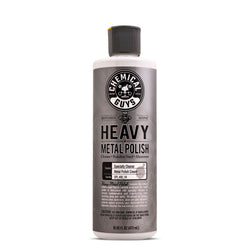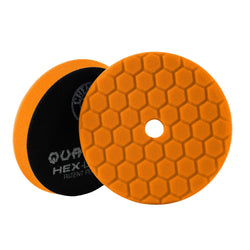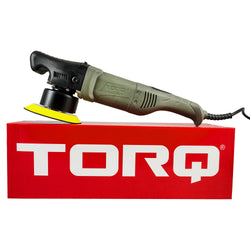| Exterior How-To's | |
| Interior How-To's | |
| Drying How-To's | |
| Latest Innovations | |
| Ceramic How-To's | |
| Detailing University |
Metal can be found on almost any car, whether it’s a chrome bumper, stainless steel exhaust tips, aluminum wheels, or any other type of metal part. Over time, metal can become oxidized and lose its shine and luster. But fear not, polishing metal on your car is a straightforward process that can restore its brilliance and extend its lifespan.
Maintaining the gleaming shine of your car’s metal parts not only enhances its visual appeal but also preserves its value.
In this guide, we’ll cover the tools, techniques, and tips you need to effectively polish your car’s metal surfaces. From selecting the right products to avoiding common mistakes, this simple tutorial will help you achieve professional results from the comfort of your garage.
Prepare Your Gear
Tools and Products You'll Need:
- Heavy Metal Polish
Used for highly oxidized and tarnished metal surfaces, it contains abrasives to remove stubborn oxidation. - Light Metal Polish
Ideal for lightly oxidized or mildly tarnished metal, it relies on chemical reactions rather than abrasives to restore shine. - Premium Grade Microfiber Applicators
Used to evenly apply the metal polish across the surface. - Workhorse Professional Grade Microfiber Towel 3-Pack (Gray)
Designed specifically for metalwork, this towel is perfect for buffing away polish and achieving a streak-free shine.
Step 1: Decide on a Polish

Selecting the appropriate polish is crucial for achieving the best results:
- Light Metal Polish: Perfect for mild oxidation, it acts like a metal wax and is safe for most surfaces, including chrome, stainless steel, and aluminum. Test a small area first to ensure compatibility.
- Heavy Metal Polish: Best for heavily oxidized or tarnished metal, its abrasive formula tackles tough grime and restores lost shine.
Pro Tip: Always start with the least aggressive option. Test a small, inconspicuous area to determine if Light Metal Polish is sufficient. If not, switch to Heavy Metal Polish.
A simple way to remember the difference between Heavy Metal Polish and Light Metal Polish is that Heavy contains abrasives, while Light relies on a chemical reaction between polish and metal to remove oxidation. Both Metal Polishes are applied the same way, so the following tutorial will work great for either one!
Step 2: Time to Polish Some Metal

To polish metal surfaces effectively, start by shaking the bottle of your Light Metal Polish thoroughly to ensure the formula is evenly mixed.
Apply two small lines of Light Metal Polish onto one of your Premium Grade Microfiber Applicators.
Use the Premium Grade Microfiber Applicator to work the polish into the metal using straight, linear motions to avoid creating swirl marks.
Let the Light Metal Polish’s formula do the work; apply gentle pressure and focus on spreading the product rather than scrubbing.
Once you have polished the area, take a gray Workhorse Professional Grade Microfiber Towel folded into quarters and use it to buff away any excess polish, revealing a streak-free, gleaming surface.
Don't Forget About These Alternative Methods
Machine + Orange Hex Logic Pad
If you need to polish a large area of metal, like the side of a big steel truck, using a machine can save you a lot of time. A machine can spread the polish much faster than you would be able to by hand. Try using a TORQ10FX with an Orange Hex-Logic Pad to get the job done! Follow the same steps as above, but simply replace the hand applicator with the machine.
If you want to try using a polisher, check out our blog: How to Choose the Right Polisher For Your Car.
Machine + Microfiber Cutting Pad
If you need to polish a diamond plate, use a machine with a Microfiber Cutting Pad. The Microfiber Cutting Pad is ideal for diamond plate as it is more aggressive and can remove hidden oxidation stuck in the grooves of the diamond plate.
For more information on choosing the right Hex-Logic Pad, check out our blog: Understanding The Hex-Logic Pad Color Chart.
Polishing the metal on your car not only restores its shine but also protects it from future wear. With the right tools and techniques, you can achieve a showroom-worthy finish and prolong the life of your car’s metal components. Follow this guide to enhance your car’s appearance and turn heads wherever you go!
Happy Detailing!
Frequent Questions About How to Polish Metal on Your Car
Will Light Metal Polish work on chrome exhausts?
Yes, Light Metal Polish is safe and effective for chrome exhausts. To clean the exhaust tip first, try our EcoSmart-RU Waterless Car Wash.
Are Light Metal Polish or Heavy Metal Polish safe for chrome-plated plastic?
No, both Light and Heavy Metal Polish should not be used on plastics. For chrome-plated plastic, try our Butter Wet Wax for gentle cleaning and protection.
Do I need to seal the metal after polishing?
While not mandatory, applying a sealant or wax can add extra protection and enhance shine. Check out our Car Waxes and Sealants Collection here.
What if the Light Metal Polish turns black during use?
This is totally normal; it's a chemical reaction that indicates the Light Metal Polish is effectively removing oxidation and contaminants.
Why do you recommend different color Microfiber Towels?
To avoid cross-contamination, from your wheels to your paint or your engine bay to your interior. Check out our Microfiber Towel Color Code System here.
To avoid cross-contamination—from your wheels to your paint, or your engine bay to your interior—use our Microfiber Towel Color Code System. Check it out.
How do you care for all the Microfiber Towels you use?
For information on caring for your microfiber products, check out our blog: How to Clean Microfiber Towels The Right Way.









